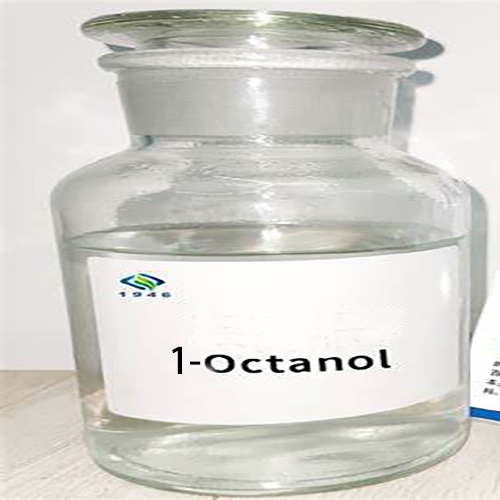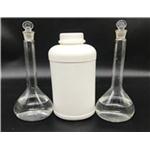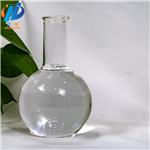How to use 1-octanol correctly
Introduction
1-octanol is an organic substance with the chemical formula of C8H18O[1]. It is slightly soluble in water and soluble in alcohol, ether and chloroform. It is a linear saturated fatty alcohol containing 8 carbon atoms. It is a colorless and transparent liquid at room temperature and pressure. 1-octanol can be used as raw materials of spices, octanal, octanoic acid and its esters, as well as solvents, defoamers and lubricating oil additives. Octanol is a kind of low toxicity. It is irritating to skin and eyes, but due to low vapor pressure, it is not dangerous to use it under general conditions.

Picture 1 1-Octanol liquid
Preparation of 1-octanol
1-octanol exists in essential oils such as bitter orange, grapefruit, sweet orange, green tea and violet leaves in free state, or in acetate, butyrate and isovalerate[2]. In industrial production, octanal can be reduced or prepared by using octanoic acid in coconut oil. It can also be prepared by carbonyl synthesis with heptene-1 as raw material. HEPTENE, carbon monoxide and hydrogen form aldehyde in the presence of cobalt salt at 150-170 ℃ and high pressure of 20-30Mpa. After cobalt removal, HEPTENE is hydrogenated to primary alcohol under pressure with nickel catalyst. This method has mature production technology abroad.
Application of 1-octanol
1-octanol is mainly used in the production of plasticizer, extractant and stabilizer, and as an intermediate of solvent and perfume. In the field of plasticizers, 1-octanol generally refers to 2-ethylhexanol, which is a bulk raw material of one million tons and is far more valuable than n-octanol in industry. Octanol itself is also used as a spice, blending roses, lilies and other flower fragrance as a soap flavor. This product is an edible spice that is allowed to be used according to Chinese GB2760-86. Mainly used to make coconut, pineapple, peach, chocolate and citrus flavors.
Hazard overview
Health hazards: 1-octanol can irritate eyes, skin, mucous membrane and upper respiratory tract.
Explosion hazard: 1-octanol is flammable and irritating.
First aid measures
Skin contact: take off the clothes polluted by 1-octanol and rinse with a large amount of flowing water.
Eye contact: lift the eyelids and rinse with flowing water or normal saline. See a doctor.
Inhalation: leave the site to a place with fresh air. If breathing is difficult, give oxygen. See a doctor.
Ingestion: drink enough warm water to induce vomiting. See a doctor.
Fire fighting measures
Hazard characteristics: 1-octanol is flammable in case of open fire and high heat.
Harmful combustion products: carbon monoxide, carbon dioxide.
Fire extinguishing method: Firefighters must wear gas masks and full body fire fighting clothes to extinguish the fire in the upwind direction. Move the container from the fire site to an open place as far as possible. Spray water to keep the containers in the fire site cool until the fire extinguishing is completed. If the container in the fire site has changed color or generated sound from the safety pressure relief device, it must be evacuated immediately.
Fire extinguishing agents: fog water, foam, dry powder, carbon dioxide and sand.
Leakage emergency treatment
Emergency treatment: quickly evacuate the personnel in the leakage pollution area to the safety area, isolate them and strictly restrict their access. Cut off the fire source. It is recommended that emergency treatment personnel wear self-contained positive pressure respirator and anti-virus clothing. Cut off the source of leakage as much as possible. Prevent from flowing into restricted spaces such as sewers and flood drainage ditches.
Small leakage: absorb with sand, vermiculite or other inert materials. It can also be washed with emulsion made of non combustible dispersant and diluted with lotion to put into the waste water system.
Massive leakage: build a dike or dig a pit for reception. Transfer to tank car or special collector by pump, recycle or transport to waste treatment site for disposal.
Handling and storage
Precautions for operation: closed operation and comprehensive ventilation. Operators must receive special training and strictly abide by the operating procedures. It is recommended that operators wear self-priming filter gas mask (half mask), chemical safety glasses, anti poison penetration work clothes and rubber gloves. Keep away from kindling and heat sources. Smoking is strictly prohibited in the workplace. Use explosion-proof ventilation system and equipment. Prevent steam from leaking into the air of the workplace. Avoid contact with oxidants and acids. Handle with care to prevent damage to packaging and containers. Fire fighting equipment and leakage emergency treatment equipment of corresponding varieties and quantities shall be provided. Empty containers may leave harmful substances.
Storage precautions: store in a cool and ventilated warehouse. Keep away from kindling and heat sources. It shall be stored separately from oxidants, acids and edible chemicals, and mixed storage shall not be allowed. Provide corresponding varieties and quantities of fire-fighting equipment. The storage area shall be equipped with leakage emergency treatment equipment and appropriate receiving materials.
Reference
1 Shi Ruijuan, Wang Fei, Mou Xiaoling, Tana, etc Effect of particle size on 1-octanol transfer dehydrogenation on Cu / MgO, 2010
2 Wang Mingquan, Ji Yongxin, Deng Jie, Guo Xin Synthesis and properties of 1-phenyl-1-octanol polyoxyethylene ether phosphate. 2018
);You may like
Lastest Price from 1-Octanol manufacturers

US $50.00-30.00/kg2024-04-30
- CAS:
- Min. Order:
- 1kg
- Purity:
- 99.8%
- Supply Ability:
- 500

US $20.00/kg2024-04-28
- CAS:
- 111-87-5
- Min. Order:
- 1kg
- Purity:
- 99.9%
- Supply Ability:
- 200000kg

